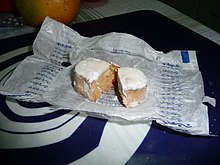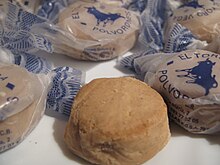| Revision as of 14:00, 28 January 2023 editCMD007 (talk | contribs)Extended confirmed users1,609 edits Africa and Asia, etcTags: Reverted Mobile edit Mobile web edit Advanced mobile edit← Previous edit | Revision as of 14:05, 28 January 2023 edit undoCMD007 (talk | contribs)Extended confirmed users1,609 edits →Regional variations: HeadingsTags: Reverted Mobile edit Mobile web edit Advanced mobile editNext edit → | ||
| Line 35: | Line 35: | ||
| ==Regional variations== | ==Regional variations== | ||
| {{unreferenced section|date=December 2016}} | {{unreferenced section|date=December 2016}} | ||
| ====Europe and Americas==== | |||
| ===Cuba=== | ===Cuba=== | ||
| In ], it is one of the most common flavors of ice cream. Cuba, being the Latin American country in the Caribbean where Spain had the most interest and influence,{{according to whom|date=June 2018}} has adapted the flavors of mantecado or polvorones from Spain into a delicious and beloved flavor for Cuban ice cream. Known worldwide for the delicious flavoring, what some{{who|date=December 2016}} might call a Latin vanilla, this Cuban flavor has influenced ice cream flavors made in other Latin American places such as Puerto Rico. | In ], it is one of the most common flavors of ice cream. Cuba, being the Latin American country in the Caribbean where Spain had the most interest and influence,{{according to whom|date=June 2018}} has adapted the flavors of mantecado or polvorones from Spain into a delicious and beloved flavor for Cuban ice cream. Known worldwide for the delicious flavoring, what some{{who|date=December 2016}} might call a Latin vanilla, this Cuban flavor has influenced ice cream flavors made in other Latin American places such as Puerto Rico. | ||
| ===Philippines=== | |||
| ⚫ | ] ]-flavored polvorón from ]]] | ||
| ⚫ | The Filipino version of polvorón (sometimes spelled "polboron" or "pulburon") uses a large amount of ] which is left dry, as well as toasted flour, ], and ] or ] instead of lard. In contrast to other polvorón, it has a very fine powder-like and dry consistency. A number of local variants on the traditional ''polvorón'' recipe have been made. Well-known variants include ''polvorón'' with ''kasuy'' (]), with '']'' (pounded and toasted young green rice, similar to ]) and with '']'' leaves. Strawberry, chocolate-coated, '']'' (purple yam), peanut, and ] flavoured ''polvorón'' also exist. | ||
| ===Spain=== | ===Spain=== | ||
| Line 48: | Line 44: | ||
| ===United States=== | ===United States=== | ||
| Sometimes called Pan de Polvo, the sweet is made with ] in the south ] region. | Sometimes called Pan de Polvo, the sweet is made with ] in the south ] region. | ||
| ====Elswhere==== | |||
| ===Asia=== | |||
| ⚫ | ] ]-flavored polvorón from ]]] | ||
| ⚫ | The Filipino version of polvorón (sometimes spelled "polboron" or "pulburon") uses a large amount of ] which is left dry, as well as toasted flour, ], and ] or ] instead of lard. In contrast to other polvorón, it has a very fine powder-like and dry consistency. A number of local variants on the traditional ''polvorón'' recipe have been made. Well-known variants include ''polvorón'' with ''kasuy'' (]), with '']'' (pounded and toasted young green rice, similar to ]) and with '']'' leaves. Strawberry, chocolate-coated, '']'' (purple yam), peanut, and ] flavoured ''polvorón'' also exist. | ||
| ==See also== | ==See also== | ||
Revision as of 14:05, 28 January 2023
Andalusian shortbread Two halves of a polvorón Two halves of a polvorón | |
| Type | Shortbread |
|---|---|
| Place of origin | Spain |
| Region or state | Andalusia |
| Main ingredients | Flour, sugar, milk, nuts |
| Similar dishes | |


A polvorón (From polvo, the Spanish word for powder, or dust) is a type of heavy, soft, and very crumbly Spanish shortbread made of flour, sugar, milk, and nuts (especially almonds). They are mostly produced in Andalusia, where there are about 70 factories that are part of a syndicate that produces polvorones and mantecados. Under the name mantecados, these sweets are a traditional preparation of other areas of the Iberian Peninsula as well.
Polvorones are popular holiday delicacies in all of Spain, Hispanic America and other Spanish-influenced countries around the world. Traditionally, they were prepared from September to January, but they are now available all year round.
Mantecado
Mantecado is a name for a variety of Spanish shortbreads that includes the polvorón. Often both names are synonymous, but not all mantecados are polvorones. The name mantecado comes from manteca (lard), usually the fat of Iberian pig (cerdo ibérico), with which they are made, while the name polvorón is based on the fact that these cakes crumble easily into a kind of dust in the hand or the mouth.
In Cuba and Puerto Rico, mantecado is an ice cream and in Spain it may be also the name given to a kind of sweet sherbet. In the Philippines, mantecado is a popular traditional ice cream flavour, characterised as a mixture of vanilla and butter. It was served during the 29 September 1898 luncheon banquet that followed the Malolos Congress' ratification of the Philippine Declaration of Independence in June that year 1935.
Regional variations
| This section does not cite any sources. Please help improve this section by adding citations to reliable sources. Unsourced material may be challenged and removed. (December 2016) (Learn how and when to remove this message) |
Europe and Americas
Cuba
In Cuba, it is one of the most common flavors of ice cream. Cuba, being the Latin American country in the Caribbean where Spain had the most interest and influence, has adapted the flavors of mantecado or polvorones from Spain into a delicious and beloved flavor for Cuban ice cream. Known worldwide for the delicious flavoring, what some might call a Latin vanilla, this Cuban flavor has influenced ice cream flavors made in other Latin American places such as Puerto Rico.
Spain
Polvorones are a common Christmas dessert in Spain. Today, there are other options for the fat used in the sweet other than pig fat, like butter, as well as vegetarian polvorones and mantecados made with olive oil.
United States
Sometimes called Pan de Polvo, the sweet is made with anise in the south Texas region.
Elswhere
Asia

The Filipino version of polvorón (sometimes spelled "polboron" or "pulburon") uses a large amount of powdered milk which is left dry, as well as toasted flour, sugar, and butter or margarine instead of lard. In contrast to other polvorón, it has a very fine powder-like and dry consistency. A number of local variants on the traditional polvorón recipe have been made. Well-known variants include polvorón with kasuy (cashew nut), with pinipig (pounded and toasted young green rice, similar to crisped rice) and with malunggay leaves. Strawberry, chocolate-coated, ube (purple yam), peanut, and cookies and cream flavoured polvorón also exist.
See also
References
- "Spanish mantecado: sweet treat beats economic downturn". Archived from the original on 2009-08-04.
- "Herrera del Duque, Extremadura - Gastronomía". Archived from the original on 2018-02-21. Retrieved 2011-01-18.
- Helado mantecado
- Dy-Zulueta, Dolly (21 November 2014). "Gene Gonzales recreates Malolos Congress dinner of 1898". InterAksyon.com (in English, Tagalog, and Spanish). Archived from the original on 10 January 2015. Retrieved 10 January 2015.
| Culture of Andalusia | ||
|---|---|---|
| History |  | |
| Language | ||
| Sports | ||
| Cuisine | ||
| Musical instruments | ||
| Traditional music | ||
| Traditions and feasts | ||
| Music festivals | ||
| Symbols | ||
| Category | ||
